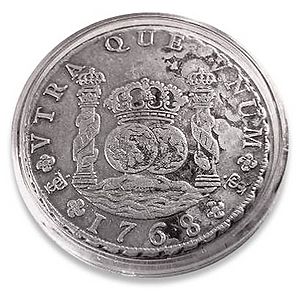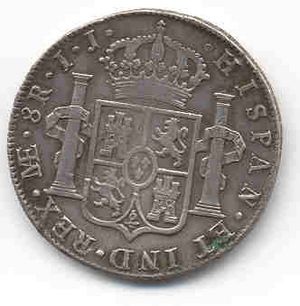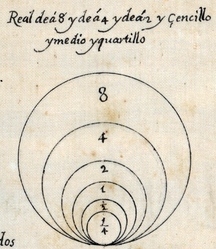Spanish real facts for kids
The real (pronounced ray-AL) was a type of money used in Spain for many centuries, starting in the mid-1300s. Its name means "royal." The value of the real changed over time until it was replaced by the peseta in 1868. The most famous real coin was the silver eight-real coin, also known as the Spanish dollar or peso. This coin was used all over Europe, America, and Asia when the Spanish Empire was at its most powerful.
Contents
History of the Spanish Real
Early Reales in Spain and America
The first real coin was introduced by King Pedro I of Castile in the mid-1300s. It was made of silver. Over time, other silver coins were removed, and the real became the main coin.
After silver was discovered in places like Mexico, Peru, and Bolivia in the 1500s, the 8-real coin became very important. People started calling it a dollar, a peso, or a piece of eight. It was used for trade all around the world. Gold coins called escudos were also made, and they were worth about 15 to 16 silver reales.
This original real, which was worth one-eighth of a dollar, continued to be used in Latin America for a long time. However, in Spain itself, the real's value changed quite a bit starting in the 1600s.
Changes to the Real in Spain (1600s-1700s)
During the time of King Philip II, Spain faced money problems. This led to a new type of coin called the real de vellón. This coin was made with less silver, or sometimes almost no silver at all. Because different parts of Spain had their own rules, the value of these reales varied a lot. This caused a lot of confusion.
By 1737, the government tried to fix the money system. They decided that one dollar would be worth 20 reales de vellón. This helped make the system clearer.
Other changes happened too. The silver dollar coins were made with slightly less pure silver. Gold escudos were also changed and became worth 2 dollars or 40 reales de vellón. By 1810, the silver coins were given simpler values based on the real de vellón, like 1, 2, 4, 10, and 20 reales.
The Real in the 1800s
In the early 1800s, Spain lost many of its colonies in America. This meant less silver and gold came into Spain. French money started to be used more often.
Spain tried to create a new money system in 1850, where the real de vellón was divided into 100 céntimos. Then, in 1864, they introduced a new silver escudo coin, which was worth 10 reales de vellón.
The real was finally stopped completely in 1868. It was replaced by the Spanish peseta, which was similar in value to the French franc. One dollar became worth 20 reales, or 5 pesetas. Even after it was no longer a coin, the word "real" was still sometimes used to mean a quarter of a dollar (25 céntimos of a peseta).
Coins of the Real
From the 1500s to the 1800s, coins were made in both Spain and Latin America. Silver coins came in values of 1/2, 1, 2, 4, and 8 reales nacional. Gold coins were made in 1/2, 1, 2, 4, and 8 escudos.
The silver 8-real coin was very famous. It was known as the Spanish dollar, peso, or the well-known piece of eight. These coins were made to be similar to the thaler coins from other parts of Europe. Spanish dollars made between 1732 and 1773 are often called columnarios because of the design on them. Later coins, from 1772 onwards, often had a portrait of the king.
In Spain, copper coins were made in values like 1, 2, 4, and 8 maravedíes. Silver coins were made for 1, 2, 4, 10, and 20 reales de vellón starting in 1737. Gold coins were also made for 1/2, 1, 2, 4, and 8 escudos. After 1850, new copper coins like 5, 10, and 25 céntimos de real were introduced, along with a new gold 100-real coin.
See also
 In Spanish: Real español para niños
In Spanish: Real español para niños
- Columnarios
- Currency of Spanish America
- Portuguese real
- Real de alerce
- Spanish colonial real






